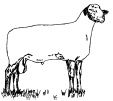

To send a message to an author, click on the author's name at the end of the article.
This Month in Ag Connection | Ag Connection - Other Issues Online
As of January 1, 2017 the Veterinary Feed Directive (VFD) governing all feed-grade antibiotics which are considered medically important is in effect. Over the past several years, there has been a growing concern regarding bacterial resistance to antibiotics. There is no science-based researched which supports a link between antibiotic-use in livestock with antibiotic resistant bacterial infections in humans. Despite this fact, the VFD will increase veterinary direction of therapeutic uses of medically important antibiotics. Examples of drugs considered critically or highly important to humans include Excede, Draxxin, Lincomycin, Penicillin and the Tetracyclines.

Following are some key points:

Antibiotics approved for use under the VFD will be for "prevention", "treatment", and/or "control" of specific bacterial diseases
Antibiotics are sometimes a necessary part of raising food animals. Without them, animal welfare may be compromised and food safety may be put at risk. By regulating animal medicine more closely, the government can assure the public that farmers use antibiotics responsibility and do not pose a risk to human health.
Source: Heather Conrow, Livestock Specialist
This Month in Ag Connection | Ag Connection - Other Issues Online
Typically in January most farmers are thinking about finishing up the previous year records and setting up appointments to see their tax preparer. Those things continue to be very important and high priority, but while thinking about taxes following are some new things to consider.

Beginning in 2017, employers must file their information returns (W-2, 1099-MISC for non-employee compensation) with the Social Security Administration by January 31. For several years, January 31st has been the date the forms are required to be provided to the employees and independent contractors. The change is that now those forms are due to Social Security by January 31st. In past years if they were submitted by paper copy they were due the end of February and if filed electronically they were due the end of March. So, whether you do them yourself, or if you have your tax preparer file them for you be sure to get them in. Tax preparers would appreciate the information in early January. This change was part of the Protecting Americans from Tax Hikes (PATH) Act signed into law December 2015.
The penalties per W-2 or 1099-MISC for missing the January 31st deadline are as follows:
The reason for the change in filing dates is to help prevent fraud. There were many fraudulent returns submitted after January 31st and before the forms were filed.
Another IRS change or repair regulation is the tangible property regulation de minimis safe harbor. De minimis is a Latin word meaning "too minimal to merit consideration". Basically, it means taxpayers may elect to deduct the cost of tangible property, rather than recovering the cost through depreciation expense. The deduction increased from $500 to $2,500 per item. The most likely example would be small equipment purchases. It is best not to use this on something which may increase in value, or it may increase the tax owed later when sold.
This past fall, the Missouri legislature overrode the Governor's veto of Senate Bill 641. The bill creates a state income tax deduction for disaster payments related to livestock programs. Examples of livestock disaster payments include livestock indemnity payments, pasture insurance, livestock risk protection insurance and many others. This law is retroactive to January 1, 2014 and applies only to USDA disaster declared counties. This winter a review of past records may be warranted to determine if an amended state tax return is needed, or visit with a tax preparer. The Missouri Department of Revenue is still determining the final interpretation of this law.
The PATH Act addressed Section 179 and bonus depreciation. Section 179 maximum "expensing" deductions is now permanent with the 2017 amount being $500,000. The 2017 amount for maximum first year additional depreciation (bonus depreciation) is 50%. Bonus depreciation will decrease in 2018 to 40%.
There is a high probability there will be some sort of federal tax change in 2017, with the change in administration. It will be interesting to follow any changes and share the farm related issues in this newsletter.
Source: Mary Sobba, Ag Business Specialist
This Month in Ag Connection | Ag Connection - Other Issues Online
The Northeast Missouri Show-Me-Select Replacement heifer sale in Palmyra, Missouri, on December 10th, averaged $2,054.
The MU educational heifer management program included 20 producers with 240 heifers. The heifers were bred to sires with calving-ease and growth genetics. The top lot sold belonged to Keithley/Jackson and brought $2,800.
Highest average price from a consignor was $2,522 on 9 head from Keithley/Jackson, Frankford, Mo. Other top consignors were Kirby Latimer, first time consignor from Hunnewell Mo. $2,300 on 4 head; Gene and Kim Dryden, Hannibal, Mo. $2,214 on 14 head; and Prairie View Farms, Monroe City, Mo. $2,188 on 21 head.
Forty-one buyers purchased just under $500,000 worth of bred heifers. Twenty-five repeat buyers purchased 169 head, or 70 percent of the total consignment. Calving surveys returned by these buyers provide important information to consignors to improve animals consigned to future sales.
The Show-Me-Select heifer development program takes nearly a year to complete. The heifers undergo a pre-breeding examination usually 4 to 8 weeks before to breeding. This exam includes a pelvic measurement, reproductive tract score, and weight. Heifers may be bred artificially or by natural service. Sires must meet specific calving ease EPD requirements based upon breed. This year 170 head, or 71 percent, of the heifers in the sale were synchronized and bred AI. The choice to AI had a $57 price advantage over those bred naturally in the sale.
Heifers must be pregnancy tested within 90 days of breeding by a veterinarian to determine expected calving date. The use of ultrasound has helped many of the veterinarians improve their accuracies on calving dates. During the development period the heifers undergo an extensive health program and are vaccinated at weaning, pre-breeding, and pregnancy
examination as well as treated several times for internal and external parasites. Heifers are also screened for blemishes, body condition, muscling and structural soundness by an MU Extension livestock specialist and USDA graders.
Averages of other Show-Me-Select sales from fall 2016 were Farmington, $1,518 on 117 head; Joplin, $1,651 on 364 head; Kirksville, $1,731 on 149 head; Kingsville, $1,910 on 148 head; and Fruitland, $1,962 on 96 head.
This was the 20th year for the Show-Me-Select heifer sale in Palmyra and over 35,800 heifers have been through the program and 5,831 head have been sold. There were several new consignors this year and more are expected to start next year. If you are interested in the program, contact your local MU Extension livestock specialist.
Source: Daniel Mallory, Livestock Specialist
This Month in Ag Connection | Ag Connection - Other Issues Online
The Affordable Care Act (ACA) will be around in the coming year. What is known is:
Open enrollment continues until January 31, 2017. After January, if life situations change, special enrollment might be an option. Special enrollment situations include:
The penalty for not having health insurance for 2016 is 2.5% of yearly income above the filing threshold or a flat fee of $695 per adult and $347.50 per child through age 18 (flat fee capped at $2,085 per family). The higher of the two will be assessed. Beginning in 2017, the flat fee will be adjusted for inflation.
Penalties are assessed through the tax-filing process. The penalty for not having coverage in 2015 was paid when filing taxes in 2016. The penalty is assessed based on number of months without health insurance for the year. There is no penalty if insurance was had for nine months of the year.
It should be noted the following form may need to be included with an income tax return:
The following forms are provided by insurers to help with income tax preparation:
If one does not comply with the mandate and is not exempt, the IRS has two options: To ask for the money or to reduce the size of the tax refund.
To answer specific questions, a team of regional extension specialists in the Northeast Region can be contacted through your local extension office or http://extension.missouri.edu/insure/northeast.aspx
Source: Darla Campbell, Ag Business Specialist

Publishing Information
Ag Connection is published monthly for Northeast and Central areas of Missouri producers and is supported by the University of Missouri Extension, the Missouri Agricultural Experiment Station, and the MU College of Agriculture, Food and Natural Resources. Managing Editor: Mary Sobba.